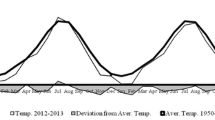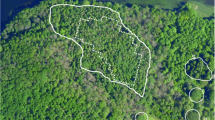Abstract
•Context
The abundance and distribution of tree regeneration is driven by several processes acting at both the seedling establishment and survival stages. Plant– plant interactions highly contribute to regeneration dynamics through seed dispersal and competition or facilitation processes.
•Aims
The aim of the present study was to assess the relative importance of different functional groups of shrubs for the early establishment of oak seedlings in the coastal forest communities of south-western France.
•Material and methods
We applied spatial and non-spatial analysis methods in eleven 315-m2 regeneration plots. Within each plot, oak seedlings (height <25 cm) and shrubs (height >50 cm and DBH <4 cm) were mapped to ±1 cm. The spatial distribution patterns of the oak seedlings (Quercus robur, Quercus suber and Quercus ilex) were analysed for each species while the association patterns were detected between the seedlings of the three oaks and four functional groups of shrubs (Fagaceae, Ericaceae, Fabaceae and spiny shrubs) known to have contrasting effects on other species.
•Results
Oak seedling species were very often spatially aggregated at short distances (<1 m). Oak seedlings were also positively associated with shrubs of the same species within the Fagaceae group, whereas we detected negative associations with Ericaceae and no dominant significant pattern for Fabaceae and spiny shrubs.
•Conclusion
The aggregated distribution of seedlings of the three oak species was due to short-distance seed dispersal, which also explained their positive spatial associations with Fagaceae shrubs. Thus, in order to enhance oak recruitment in these ecosystems, forest managers should focus on the control of Ericaceae shrubs, while preserving Fagaceae shrubs.



Similar content being viewed by others
References
Andersson C (1991) Distribution of seedlings and saplings of Quercus robur in a grazed deciduous forest. J Veg Sci 2:279–282
Ballester A, Vieitez AM, Vieitez E (1982) Allelopathic potential of Erica vagans, Calluna vulgaris, and Daboecia cantabrica. J Chem Ecol 8:851–857
Callaway RM (1995) Positive interactions among plants. Bot Rev 61:306–349
Cuesta B, Villar-Salvador P, Puertolas J, Benayas JMR, Michalet R (2010) Facilitation of Quercus ilex in Mediterranean shrubland is explained by both direct and indirect interactions mediated by herbs. J Ecol 98:687–696
Cushman JH, Waller JC, Hoak DR (2010) Shrubs as ecosystem engineers in a coastal dune: influences on plant populations, communities and ecosystems. J Veg Sci 21:821–831
David TS, Henriques MO, Kurz-Besson C, Nunes J, Valente F, Vaz M, Pereira JS, Siegwolf R, Chaves MM, Gazarini LC, David JS (2007) Water-use strategies in two co-occurring Mediterranean evergreen oaks: surviving the summer drought. Tree Physiol 27:793–803
Dullinger S, Kleinbauer I, Pauli H, Gottfried M, Brooker R, Nagy L, Theurillat JP, Holten JI, Abdaladze O, Benito JL, Borel JL, Coldea G, Ghosn D, Kanka R, Merzouki A, Klettner C, Moiseev P, Molau U, Reiter K, Rossi G, Stanisci A, Tomaselli M, Unterlugauer P, Vittoz P, Grabherr G (2007) Weak and variable relationships between environmental severity and small-scale co-occurrence in alpine plant communities. J Ecol 95:1284–1295
Eppard HR, Horton JL, Nilsen ET, Galusky P, Clinton BD (2005) Investigating the allelopathic potential of Kalmia latifolia L. (Ericaceae). Southeast Nat 4:383–392
Fajardo A, McIntire E (2011) Under strong niche overlap conspecifics do not compete but help each other to survive: facilitation at the intraspecific level. J Ecol 99:642–650
Forey E, Chapelet B, Vitasse Y, Tilquin M, Touzard B, Michalet R (2008) The relative importance of disturbance and environmental stress at local and regional scales in French coastal sand dunes. J Veg Sci 19:493–502
Gómez JM (2003) Spatial patterns in long-distance dispersal of Quercus ilex acorns by jays in a heterogeneous landscape. Ecography 26:573–584
Gómez-Aparicio L, Zamora R, Hodar JA, Castro J, Baraza E (2004) Applying plant positive interactions to reforestation of Mediterranean mountains: a meta-analysis of the use of shrubs as nurse plants. Ecol Appl 14:1128–1138
Gonzalez-Martinez SC, Bravo F (2001) Density and population structure of the natural regeneration of Scots pine (Pinus sylvestris L.) in the High Ebro Basin (Northern Spain). Ann For Sci 58:277–288
Goreaud F, Courbaud B, Collinet F (1999) Spatial structure analysis applied to modeling of forest dynamics: a few examples. In: Amaro A, Tomé M (eds) Empirical and process based models for forest tree and stand growth simulation. Novas Tecnologias, Oeiras, pp 155–172
Harms KE, Condit R, Hubbell SP, Foster RB (2001) Habitat associations of trees and shrubs in a 50-ha neotropical forest plot. J Ecol 89:947–959
Hille Ris Lambers J, Clark JS (2003) Effects of dispersal, shrubs, and density-dependent mortality on seed and seedling distributions in temperate forests. Can J For Res 33:783–795
Kunstler G, Curt T, Lepart J (2004) Spatial pattern of beech (Fagus sylvatica L.) and oak (Quercus pubescens Mill.) seedlings in natural pine (Pinus sylvestris L.) woodlands. Eur J For Res 123:331–337
Loosmore NB, Ford ED (2006) Statistical inference using the G or K point pattern spatial statistics. Ecology 87:1925–1931
Maltez-Mouro S, Garcia LV, Maranon T, Freitas H (2007) Recruitment patterns in a Mediterranean oak forest: a case study showing the importance of the spatial component. For Sci 53:645–652
Maun MA (1998) Adaptations of plants to burial in coastal sand dunes. Can J Bot 76:713–738
McDonald RI, Peet RK, Urban DL (2003) Spatial pattern of Quercus regeneration limitation and Acer rubrum invasion in a Piedmont forest. J Veg Sci 14:441–450
Michalet R (1991) Une approche synthétique bio pédoclimatique des montagnes méditerranéennes: exemple du Maroc septentrional. Thèse Université Joseph Fourier, Grenoble
Michalet R (2006) Is facilitation in arid environments the result of direct or complex interactions. New Phytol 169:3–6
Muhamed H, Maalouf JP, Michalet R (2013a) Summer drought and canopy opening increase the strength of the oak seedlings-shrub spatial association. Ann For Sci 70:345–355
Muhamed H, Touzard B, Le Bagousse-Pinguet Y, Michalet R (2013b) The role of biotic interactions for the early establishment of oak seedlings in coastal dune forest communities. For Ecol Manag 297:67–74
Paluch JG (2005) The influence of the spatial pattern of trees on forest floor vegetation and silver fir (Abies alba Mill.) regeneration in uneven-aged forests. For Ecol Manag 205:283–298
Pardos M, Montes F, Canellas I (2008) Spatial dynamics of natural regeneration in two differently managed Pinus sylvestris stands before and after silvicultural intervention using replicated spatial point patterns. For Sci 54:260–272
Petritan IC, Marzano R, Petritan AM, Lingua E (2014) Overstory succession in a mixed Quercus petraea-Fagus sylvatica old growth forest revealed through the spatial pattern of competition and mortality. For Ecol Manag 326:9–17
Prentice IC, Werger MJA (1985) Clump spacing in a desert dwarf shrub community. Vegetatio 63:133–139
Purves DW, Law R (2002) Fine-scale structure in a grass-land community: quantifying the plant’s-eye view. J Ecol 90:121–129
Rameau JC, Mansion D, Dumé G (1993) Flore forestière française. Tome 2: montagnes. Institut pour le Développement Forestier, Paris
Rayburn AP, Schiffers K, Schupp EW (2011) Use of precise spatial data for describing spatial patterns and plant interactions in a diverse Great Basin shrub community. Plant Ecol 212:585–594
Richard F, Selosse MA, Gardes M (2009) Facilitated establishment of Quercus ilex in shrub-dominated communities within a Mediterranean ecosystem: do mycorrhizal partners matter? FEMS Microbiol Ecol 68:14–24
Rodriguez-Garcia E, Ordoñez C, Bravo F (2011) Effects of shrub and canopy cover on the relative growth rate of Pinus pinaster Ait. seedlings of different sizes. Ann For Sci 68:337–346
Salas C, Lemay V, Nunez P, Pacheco P, Espinosa A (2006) Spatial patterns in an old-growth Nothofagus obliqua forest in south-central Chile. For Ecol Manag 231:38–46
Sardin T (2009) Guide des sylvicultures Forêts littorales atlantiques dunaires. ONF ed. p. 175
Schleicher J, Meyer KM, Wiegand K, Schurr FM, Ward D (2011) Disentangling facilitation and seed dispersal from environmental heterogeneity as mechanisms generating associations between savanna plants. J Veg Sci 22:1038–1048
Schurr FM, Bossdorf O, Milton SJ, Schumacher J (2004) Spatial pattern formation in semi-arid shrubland: a priori predicted versus observed pattern characteristics. Plant Ecol 173:271–282
Schurr FM, Bond WJ, Midgley GF, Higgins SI (2005) A mechanistic model for secondary seed dispersal by wind and its experimental validation. J Ecol 93:1017–1028
Shumway SW (2000) Facilitative effects of a sand dune shrub on species growing beneath the shrub canopy. Oecologia 124:138–148
Skarpe C (1991) Spatial patterns and dynamics of woody vegetation in an arid savanna. J Veg Sci 2:565–572
Stoll P, Prati D (2001) Intraspecific aggregation alters competitive interactions in experimental plant communities. Ecology 82:319–327
Tirado R, Pugnaire FI (2003) Shrub spatial aggregation and consequences for reproductive success. Oecologia 136:296–301
Umeki K (1995) Importance of crown position and morphological plasticity in competitive interaction in a population of Xanthium canadense. Ann Bot 75:259–265
Wiegand T, Moloney KA (2004) Rings, circles, and null-models for point pattern analysis in ecology. Oikos 104:209–229
Wiegand T, Kissling WD, Cipriotti PA, Aguiar MR (2006) Extending point pattern analysis for objects of finite size and irregular shape. J Ecol 94:825–837
Wiegand T, Gunatilleke S, Gunatilleke N (2007) Species associations in a heterogeneous Sri Lankan dipterocarp forest. Am Nat 170:E77–E95
Acknowledgments
We are grateful to the “Office National des Forêts” (O.N.F.) for permission to work in coastal sand dune forests and, in particular, to Didier Canteloup for his advice during the site selection process. We thank Fabien Rizinjirabake and Chantal Hélou for assistance in the field and Fabio Meloni and Raffaella Marzano for CAD and GIS support. The first author received a scholarship from EU through Erasmus Mundus programme Lot 10.
Author information
Authors and Affiliations
Corresponding author
Additional information
Handling Editor: Laurent Bergès
Contribution of the co-authors
Jean-Paul Maalouf: supporting in data analysis and scientific discussion.
Emanuele Lingua: supporting in data analysis and scientific discussion.
Richard Michalet: designing and supervising the experiment.
Rights and permissions
About this article
Cite this article
Muhamed, H., Lingua, E., Maalouf, JP. et al. Shrub-oak seedling spatial associations change in response to the functional composition of neighbouring shrubs in coastal dune forest communities. Annals of Forest Science 72, 231–241 (2015). https://doi.org/10.1007/s13595-014-0419-8
Received:
Accepted:
Published:
Issue Date:
DOI: https://doi.org/10.1007/s13595-014-0419-8




